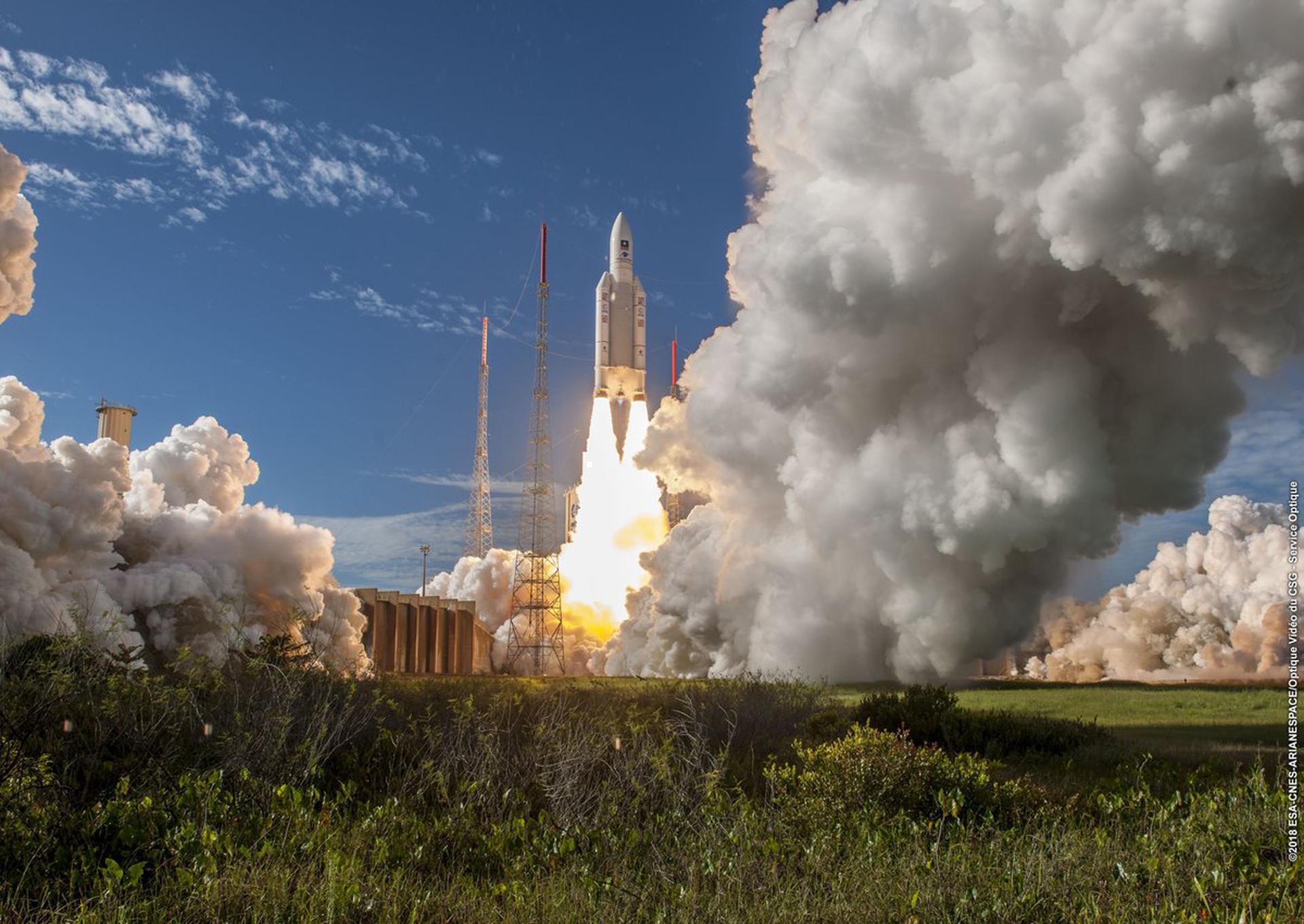
Ariane 5 ES
In-activeArianeGroup (AG)
March 9, 2008
Description
The Ariane 5 ES (Evolution Storable) has an estimated LEO launch capacity of 21,000 kg (46,000 lb). It includes all the performance improvements of Ariane 5 ECA core and boosters but replaces the ESC-A second stage with the restartable EPS used on Ariane 5 GS variants. It was used to launch the Automated Transfer Vehicle (ATV) into a 260 km circular low Earth orbit inclined at 51.6° and has been used 3 times to launch 4 Galileo navigation satellites at a time directly into their operational orbit. The Ariane 5 ES flew 8 times from 2008 to 2018 with no failures.
Specifications
-
Max Stage
2 -
Length
45.7 m -
Diameter
5.4 m -
Fairing Diameter
5.4 m -
Launch Mass
746.0 T -
Thrust
11400.0 kN -
Apogee (Sub-Orbital)
40000.0 km
Family
-
Name
Ariane 5 ES -
Family
― -
Variant
ES -
Alias
― -
Full Name
Ariane 5 ES
Payload Capacity
-
Launch Cost
― -
Low Earth Orbit
21000.0 kg -
Geostationary Transfer
Orbit
― -
Direct Geostationary
― -
Sun-Synchronous Capacity
―
ArianeGroup
Commercial
CEO: Martin Sion
AG 2015ArianeGroup (formerly Airbus Safran Launchers) is an aerospace company based in France. A joint venture between Airbus and Safran, the company was founded in 2015 and is headquartered in Issy-les-Moulineaux. It consists of three core arms: aerospace, defence and security.
Ariane 5 ES | Galileo L10 (FOC FM19-FM22)
ArianeGroup | FranceGuiana Space Centre, French Guiana
July 25, 2018, 11:25 a.m.
Status: Launch Successful
Mission:
The Galileo constellation is ESA's satellite navigation system and is expected to be completed by 2020. Galileo will provide Europe with an alternative to the American GPS and Russian GLONASS constellations, but will be interoperable with both systems.
Medium Earth Orbit #VA244Ariane 5 ES | Galileo L9 (FOC FM15-FM18)
ArianeGroup | FranceGuiana Space Centre, French Guiana
Dec. 12, 2017, 6:36 p.m.
Status: Launch Successful
Mission:
The Galileo constellation is ESA's satellite navigation system and is expected to be completed by 2020. Galileo will provide Europe with an alternative to the American GPS and Russian GLONASS constellations, but will be interoperable with both systems.
Medium Earth OrbitAriane 5 ES | Galileo L8 (FOC FM07 & FM12-FM14)
ArianeGroup | FranceGuiana Space Centre, French Guiana
Nov. 17, 2016, 1:06 p.m.
Status: Launch Successful
Mission:
The Galileo constellation is ESA's satellite navigation system and is expected to be completed by 2020. Galileo will provide Europe with an alternative to the American GPS and Russian GLONASS constellations, but will be interoperable with both systems.
Medium Earth OrbitAriane 5 ES | ATV-5 (Georges Lemaitre)
ArianeGroup | FranceGuiana Space Centre, French Guiana
July 29, 2014, 11:47 p.m.
Status: Launch Successful
Mission:
ATV-5 is the Automated Transfer Vehicle operated by the European Space Agency (ESA) to resupply the international space station (ISS) with propellant, water, air and dry cargo. After 15 days in orbit it docked to the ISS on 12th August 2014.
Low Earth OrbitAriane 5 ES | Albert Einstein ATV (ATV-004)
ArianeGroup | FranceGuiana Space Centre, French Guiana
June 5, 2013, 9:52 p.m.
Status: Launch Successful
Mission:
ATV-4 is the Automated Transfer Vehicle operated by the European Space Agency (ESA) to resupply the international space station (ISS) with propellant, water, air and dry cargo. After 10 days in orbit it docked to the ISS on 15th June 2013.
Low Earth OrbitAriane 5 ES | Edoardo Amaldi ATV (ATV-003)
ArianeGroup | FranceGuiana Space Centre, French Guiana
March 23, 2012, 4:34 a.m.
Status: Launch Successful
Mission:
ATV-3 is the Automated Transfer Vehicle operated by the European Space Agency (ESA) to resupply the international space station (ISS) with propellant, water, air and dry cargo. After 5 days in orbit it docked to the ISS on 23rd March 2012.
Low Earth OrbitAriane 5 ES | Johannes Kepler ATV (ATV-002)
ArianeGroup | FranceGuiana Space Centre, French Guiana
Feb. 16, 2011, 9:51 p.m.
Status: Launch Successful
Mission:
ATV-2 is the Automated Transfer Vehicle operated by the European Space Agency (ESA) to resupply the international space station (ISS) with propellant, water, air and dry cargo. After 8 days in orbit it docked to the ISS on 24th February 2011.
Low Earth OrbitAriane 5 ES | ATV-1 "Jules Verne"
ArianeGroup | FranceGuiana Space Centre, French Guiana
March 9, 2008, 4:03 a.m.
Status: Launch Successful
Mission:
ATV-1 is the Automated Transfer Vehicle operated by the European Space Agency (ESA) to resuplly the international space station (ISS) with propellant, water, air and dry cargo. After three weeks of orbit testing it rendezvoused with the ISS on 3rd April 2008.
Low Earth OrbitLong March 8A
SatNet LEO Group 14
Commercial LC-1 - Wenchang Space Launch Site, People's Republic of ChinaA batch of Low Earth Orbit communication satellites for the Chinese state owned SatNet constellation operated by the China Satellite Network Group. …
Kuaizhou-1A
Traffic VDES A & B
Launch Area 95A - Jiuquan Satellite Launch Center, People's Republic of ChinaTwo technology demonstration satellites for satellite transmissions of signals for the VHF Data Exchange System (VDES), a successor to the current Au…
Falcon 9
Starlink Group 11-25
Space Launch Complex 4E - Vandenberg SFB, CA, USAA batch of 28 satellites for the Starlink mega-constellation - SpaceX's project for space-based Internet communication system.
Zhuque-3
Demo Flight
Launch Area 96B - Jiuquan Satellite Launch Center, People's Republic of ChinaFirst test launch of LandSpace’s ZQ-3 rocket, with a dummy payload. The rocket’s 1st stage will attempt to land on a landing pad about 300 km downran…
Falcon 9
Starlink Group 6-95
Space Launch Complex 40 - Cape Canaveral SFS, FL, USAA batch of 29 satellites for the Starlink mega-constellation - SpaceX's project for space-based Internet communication system.

